Irish Furniture designer and architect Eileen Gray pioneered the Modern Architecture and Deco Design Styles. Her designs are said to have inspired Le Corbusier.
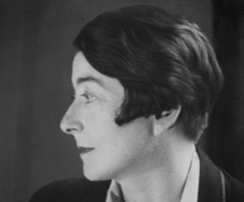
Image source: https://en.wikipedia.org/wiki/Eileen_Gray#/media/File:Eileen_Gray.jpg
Shoulders for the Giants
Born in an aristocratic Irish-Scottish family on the 9th of August 1878, Kathleen Eileen Moray Gray, had a strong interest in the arts and design from a tender age. Under her father’s tutelage, she attended the Slade School of Fine Art and was one of the first female students to do so. Then, after becoming fascinated with Art Noveau at the Paris World Fair, she continued her studies in the French capital.
There, she became known as a designer of lacquered walls and decorative panels, eventually opening her own private gallery where her designs for lamps, tables and other pieces of furniture were displayed. Additionally, she met, through the Salomn d’Autumne, the likes of Gropius, Le Corbusier, Robert Mallet-Stevens and Jean Badovici. Additionally, she built her most famous creation, Villa E-1027, in accordance with Le Corbusier and the Bauhaus‘ theories. However, after her split from Badovici and Le Corbusier’s vandalization of her eight walls, she abandoned the group and her craft.
After sojourning in South France during World War II, she transferred back to Paris, and she grew further isolated. However, in 1968, an article by Joseph Rykwert on the Domus magazine brought the spotlight back on her work, and soon her furniture pieces re-entered production.
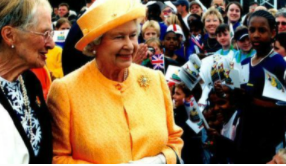
Image source: https://commons.wikimedia.org/wiki/File:Queen_Elizabeth_II_and_Eileen_Gray.jpg
After her death, in 1976, the National Museum of Ireland, in Dublin, acquired her full archive, eventually setting up a permanent exhibit, opening in 2002. In addition, her desired are still produced. Further, a movie titled, “The Price of Desire,” details her life and became available in 2015.
Her theories on design and architecture have left an indelible mark on our ideas of modern living standards, with her tubular steel furniture, revolutionary at the time of their creation, still regarded as a classic today. She is the epitome of Modernism and is the only woman whose name is mentioned in the same breath as Le Corbusier, Mies van der Rohe and Marcel Breuer.
Her major works
Her next major contribution to design was in architecture. Encouraged by Le Corbusier and J.J.P Oud, she designed two houses in the Alpes Maritimes: one at Roquebrune, which was built from 1926-1929, and the other at Castellar, built from 1932-1934. Both are considered to be the purest examples of domestic architecture and interior design of the period. The inter-war years also saw Gray’s ‘Centre des Vacances’ project, which was shown in Le Corbusier’s Pavilion des Temps Nouveaux at the Paris International Exhibition of 1937.
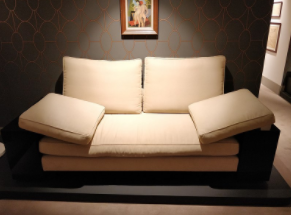
Image source: https://commons.wikimedia.org/wiki/File:EileenGray_sofa.jpg
Her design style was as distinctive as her way of working, and Gray developed an opulent, luxurious take on the geometric shapes and industrial materials used at the time, in design and architecture alike.
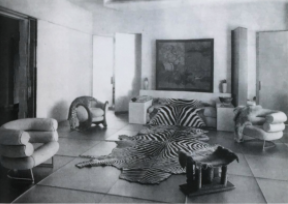
However, the high point of her career was her appointment to the Royal Society of Art in London in 1972 as Royal Designer to Industry. Moreover, the Museum of Modern Art added her legendary Adjustable Table E 1027 to its permanent design collection in 1978.
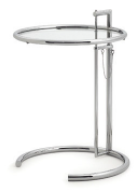
Image source: https://www.architonic.com/en/product/classicon-adjustable-table-e-1027/1014841#&gid=1&pid=1
Made from soft leather and tubular steel, the Bibendum Chair and its clinically chic E-1027 glass and tubular steel table are now as familiar as icons of the International Style.
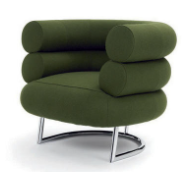
Image source: https://www.architonic.com/en/product/classicon-bibendum/1014845#&gid=1&pid=1
Other Famous Works
Chairs
- Aixia (1928)
- Bar Stool No. 1
- Bar Stool No. 2
- Bonaparte (1935)
- Non Conformist (1926)
- Roquebrune (1927)
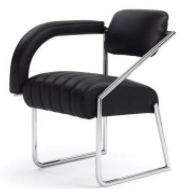
Image source: https://www.architonic.com/en/product/classicon-non-conformist/1003420#&gid=1&pid=1
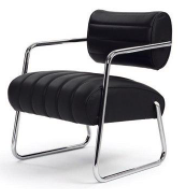
Image source: https://www.architonic.com/en/product/classicon-bonaparte/1014854#&gid=1&pid=1
Tables
- De Stijl (1922)
- Double X (1928)
- Jean (1929)
- Lou Perou (1926)
- Menton (1932)
- Occasional Table (1927)
- Petite Coiffeuse (1926)
- Rivoli (1928)
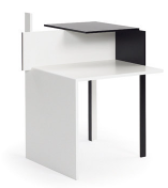
image source:https://www.architonic.com/en/product/classicon-de-stijl/1007844#&gid=1&pid=1
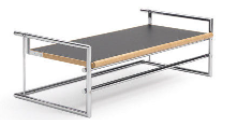
image source: https://www.architonic.com/en/product/classicon-menton-position-1/1014848#&gid=1&pid=1
Lighting
- Pailla (1927)
- Roattino (1931)
- Tube Light (1927)
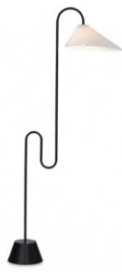
Image source: https://www.architonic.com/en/product/classicon-roattino/1003428#&gid=1&pid=1
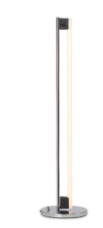
Image source: https://www.architonic.com/en/product/classicon-tube-light/1014861#&gid=1&pid=1
Info sources:
http://www.classicon.com/eileen-gray-en.html
